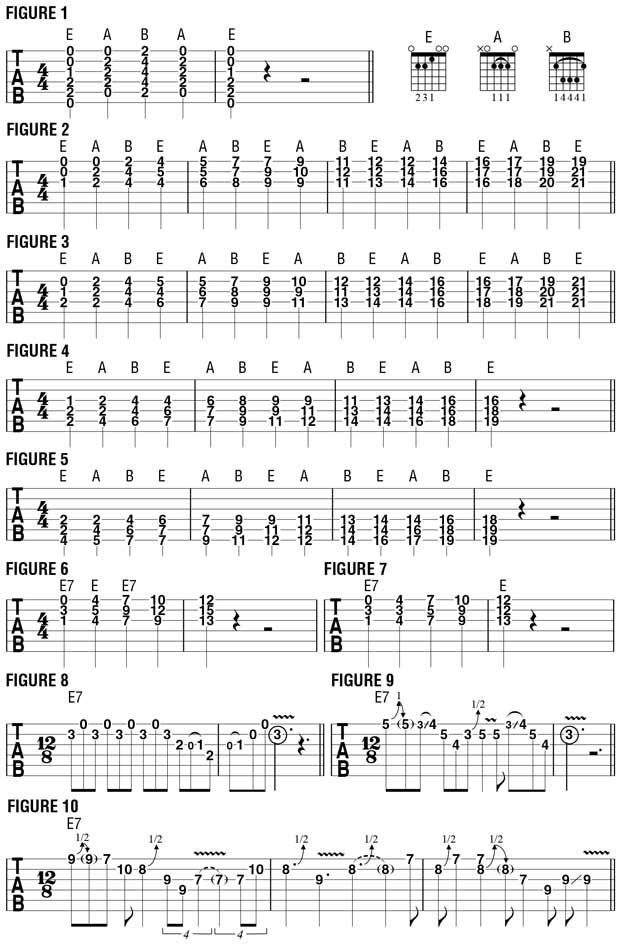Configuring Triadic Chord Shapes within the 12-Bar Blues Form

As I mentioned last time, many students over the years have asked me for a systematic approach to learning how to visualize chord shapes all over the neck, as well as how to connect them when navigating through a specific chord progression.
As stated, a lot of dedicated practice is required to memorize the basic major, minor and dominant seven chord shapes and their inversions all over the fretboard in every key. I’ve found that it’s best to start with the simplest chord forms, known as triads, which are three-note entities.
As we had done last month, let’s continue our focus on major triads, which are built from the root note, major third and fifth degrees of the major scale.
In the key of E, the three notes of an E major triad are, in ascending order, E (the root), G# (the major third) and B (the fifth). When these three notes are played together, it yields the sound of an E major chord. Previously, we looked at every possible combination of these three notes as played on three adjacent strings: the first, second and third strings; the second, third and fourth strings, and so on.
Let’s apply this approach to examining the triadic shapes for the three chords found in a standard 12-bar blues progression in E, which are the “one” chord, or tonic, E, the “four” chord, A, and the “five’ chord, B. FIGURE 1 illustrates these three chords played in standard sixth-string root and fifth-string root shapes. If we break the strings up again into groups of three adjacent strings, we can look at how to smoothly switch from E to A to B on each group while gradually moving up the fretboard.
As shown in FIGURE 2, we begin on the top three strings with an E major triad voiced, low to high, G# B E. From there, we can move to the four chord, A, by moving the G# note up a half step to A and moving the B note up a whole step to C# while keeping the E note the same on top, resulting in an A major triad voicing of A C# E. To sound a B major triad, simply move all three notes up one whole step, to B, D# and F#, respectively.
The objective here is to move to the next closest available note in the subsequent triad. So, to sound the next E major voicing, the B note remains while D# moves up to E and F# moves up to G#. As demonstrated, this process continues as we move up the fretboard. This same voice-leading technique is applied to the other three string groups In FIGURES 3–5.
The majority of blues melodies and harmonies are built from a dominant-seven sound, and FIGURES 6 and 7 apply this approach to three-note voicings of E7, A7 and B7. Now that you have these three-note shapes under your fingers, FIGURES 8–10 illustrate ways to weave solo lines around each of them.

Get The Pick Newsletter
All the latest guitar news, interviews, lessons, reviews, deals and more, direct to your inbox!
Guitar World Associate Editor Andy Aledort is recognized worldwide for his vast contributions to guitar instruction, via his many best-selling instructional DVDs, transcription books and online lessons. Andy is a regular contributor to Guitar World and Truefire, and has toured with Dickey Betts of the Allman Brothers, as well as participating in several Jimi Hendrix Tribute Tours.








![Joe Bonamassa [left] wears a deep blue suit and polka-dotted shirt and plays his green refin Strat; the late Irish blues legend Rory Gallagher [right] screams and inflicts some punishment on his heavily worn number one Stratocaster.](https://cdn.mos.cms.futurecdn.net/cw28h7UBcTVfTLs7p7eiLe.jpg)


